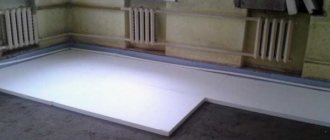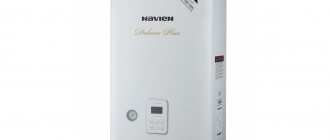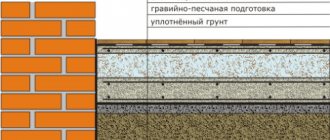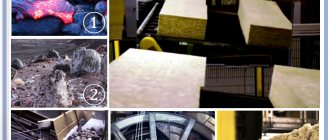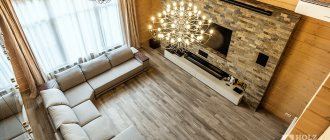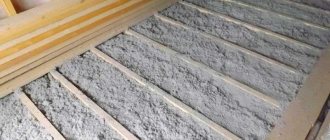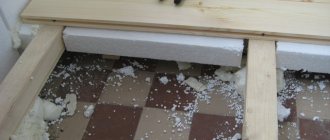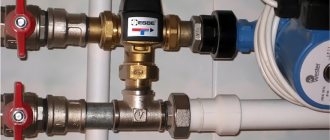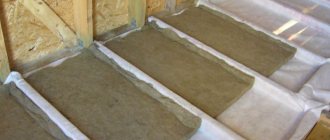What materials are needed to insulate a cold floor in a private house?
Let's look at the most popular insulation materials:
Mineral wool. The most common material for home insulation. In addition to its low cost, it is easy to install, has good sound insulation, and low thermal conductivity. Disadvantages can scare away a potential buyer. High vapor permeability without installing waterproofing calls into question the feasibility of using mineral wool for home insulation. In addition, rodents liked it.
Ecowool
Low cost, environmentally friendly material, good thermal insulation attracts the attention of buyers. But the disadvantages are the same: moisture permeability, delicacy for rodents and flammability.
Expanded polystyrene
A good heat insulator, highly resistant, and does not allow moisture to pass through. The disadvantage is the same flammability. When burned, it emits many harmful substances, so it should not be installed in a residential area.
Plywood, sawdust, chipboard. Quite popular insulation materials. They are harmless to the premises, as they do not emit poisons when burned. There are shortcomings in thermal insulation and flammability, but otherwise they are acceptable for installation. The least popular: glass wool (inconvenient to use, harmful to the body), expanded clay (has a layer too thin for thermal insulation), polystyrene foam (high fire hazard).
When choosing insulation, each owner should focus on many indicators: what is the area of the room, are the windows insulated, the interior of the house, the material component, etc.
But most importantly, the insulation must qualitatively fulfill its characteristics declared by the manufacturer and warm the occupants of the room with warmth and comfort, give comfort and serve for a long time.
Cold floor in a private house and apartment: why are the floors cold?
Are cold floors the first and most unpleasant impression of your day? Everything can be corrected. It is only important to correctly “diagnose” the problem, because the matter is not always just the lack of a “warm floor” system or the unfortunate location of the room - everything is much more interesting. Now we will look at the main causes of cold floors and ways to correct this problem.
Reason #6. Absorption of infrared rays
Also pay attention to such a physical phenomenon as infrared radiation. It happens that floors absorb heat so much that, without knowing it, you heat the underground. Laminate is a good conductor. Therefore, if everything is insulated and there are no gaps in the covering, place a layer of foil material under it, only with the front side up. You will immediately notice the difference, believe me!
Reason #7. Tactile sensations
And finally, one of the most unexpected reasons why the floor can be cold is purely tactile sensations. Simple physics is at work here: cold as a physical phenomenon does not actually exist - it is simply a lack of heat. And different materials do not have the same ability to absorb this heat from other sources. And the absorption occurs for the sake of updating the same balance. And those objects and coatings seem warmer, which take heat away from you more slowly.
So, for example, if you get up from your favorite place, you can feel with just your palm how your body has heated one part of the sofa or bench, while the other remains cold. Moreover, the heated place will be approximately the same temperature as your skin. The same applies to floors - as soon as your foot touches them, a rapid heat exchange occurs. And its intensity depends on the thermal conductivity of the flooring material: the higher it is, the colder the floor will seem, unless, however, you heat it from below.
It turns out that the approximate room temperature is about 18-20°C, and below is about 15-17°C. This is exactly the temperature the floor will have. And now you see what’s the matter: 36.6° - 17°? This is why we can experience quite unpleasant sensations from walking barefoot, even though it doesn’t seem to be cold in the house itself. And this can really make you sick - after all, heat is “downloaded” from us, and the body needs it.
So what to do? And is it then necessary to install “warm floors”? Not at all. If you definitely don’t have any cracks, and the floors aren’t freezing due to an improperly constructed underground, and it’s definitely not a matter of organizing the heating, then work with the floor covering itself. Thus, ceramic tiles have the highest thermal conductivity - they “rob” us of heat the fastest, especially in the bathroom area. And don’t walk around endlessly in rubber slippers, and the rugs in such a room can become damp. Not to mention the fact that no one will tear off the tiles again - there is no other way to put a heated floor system under it.
Here, look how they solve this problem overseas with humor and creativity:
Do-it-yourself floor insulation
It is quite simple to make a wooden frame from logs (wooden slats). Their size is chosen based on the thickness of the insulation.
In addition to the heat insulator, the log will need:
- wooden frame fasteners (dowels, screws, anchors);
- construction glue, mastic;
- waterproofing layer (in the simplest version - dense polyethylene);
- construction foam (if necessary, to fill gaps in hard-to-reach places).
The bottom layer of waterproofing is laid on the concrete base, after which the logs are attached to the concrete.
The pitch between the logs may depend on the cutting of the heat insulator; the optimal distance between the bars is 60 centimeters. Joists in apartments above wet basements can be additionally treated with water-repellent impregnations.
A heat insulator is placed in the gaps, which is covered with an outer layer of polyethylene on top.
A wooden floor base (finished floor covering) is attached to the joists. Ventilation gaps are left near the walls.
Foamed polyethylene
Perhaps the simplest type of insulation. The roll just needs to be rolled out and then cut to the required size. The individual sheets are glued together with construction tape. Many people, when deciding how to insulate the floor in an apartment under laminate, choose this type of thermal insulation. The thickness of the roll insulator is quite small, and the quality of heat conservation is at a fairly high level. In addition, a layer of laminate also partially solves the heat problem.
Insulation of the floor in an apartment on the first floor
Cold floors are typical when living on the ground floor in an old housing stock. This is due to insufficient thermal insulation of basements.
In such houses, no measures were taken to improve waterproofing, so there is dampness from below.
Floors in apartments (linoleum, laminate) are laid directly on the concrete floor, without an air gap.
Apartments on the first floor suffer the most from the cold, giving off heat to the upper rooms and not receiving heat from below. The best methods of insulation are active (using heat, electricity, water) heated floors. In many cases, it is enough to improve the floor by laying a thermal insulation layer.
Polystyrene and foam
The principle of installation and non-delivery will be similar for this insulation. To insulate the floor in an apartment with polystyrene foam, you will need to assemble a structure from wooden blocks, between which a layer of polystyrene foam will be laid. The distance between the bars is selected based on the dimensions of the polystyrene plates used. They should fit tightly between the frame elements. When all the flooring has been laid, any gaps or cracks are sealed with polyurethane foam. A finishing floor is laid on top.
What to do if the apartment has a cold floor
For starters, you can complain about cold batteries. But still, the way to solve this problem was and remains - to insulate and insulate the floor. The essence of insulating materials is their thermal insulation properties, which do not allow heat to escape outside the apartment. There are several options for insulation, let's look at the popular ones.
- Bulk materials. These include expanded clay, shavings and wood concrete. They have high thermal insulation properties and are relatively inexpensive.
- Glass wool/mineral wool (mineral wool). They are also effective in insulating floors, while the material is fireproof, is not subject to fungal infection and is hygroscopic (with mandatory vapor barrier).
- Expanded polystyrene or polystyrene foam. It has its advantages: moisture-resistant, does not ignite and is not subject to deformation, has sound-insulating properties and retains heat.
It is not possible to unequivocally answer the question of which material is better, since one must proceed from financial capabilities, the type of apartment and premises in it and their performance qualities and loads. If the apartment has wooden floors, then it is better to use mineral wool as insulation. This will save money and time. The only caveat is that polymer insulation (penoplex) is not suitable for wooden floors due to the increased flammable properties of both materials. It is more effective to use expanded clay on such coatings.
More often found in urban multi-storey panel buildings are apartments with concrete floors. It itself is a cold material, so in winter it can be cold in the apartment, plus leaky joints between the slabs, as a result - the floor becomes icy. It is interesting to know that 20% of heat loss from total heat loss comes from cold floors in apartments.
In the hallway and living room, the floor can be insulated using polystyrene foam, and in the bedroom and children's room it is better to use wood bulk material.
If the floor in the apartment is not very cold, what can you do without resorting to repair work with insulation. There are alternative options:
- Lay down a rug or rug. They have a low thermal conductivity coefficient; natural wool coatings have the greatest insulation properties.
- Lay the linoleum on a felt or jute backing, or on a foam base.
If you decide to install laminate in your apartment, then before installation you need to lay a special cork material, then you won’t have to wonder why the laminate is cold in the apartment and what to do.
So, in order for the floor to have a comfortable temperature, it is not necessary to use expensive heating structures; it is enough to properly insulate it using available materials. Find out why the batteries are cold at the bottom and hot at the top.
Cold floor in the apartment, what to do
Insulation of a concrete floor is very important for creating comfort and warmth in the house, especially if the apartment is located on the ground floor.
But wooden floors sometimes also require insulation.
For example, in a private house, no matter how well the coating is made, it does not provide a complete guarantee of heat retention, which means it will not be possible to save on heating.
Why do you need to insulate the floor?
The systemic heat exchange of a house or apartment largely depends on the floors, since they are the place of large heat loss.
Concrete is durable and has excellent performance qualities, it is popular for flooring, but it has one serious drawback - the material is very cold. If it is installed in a residential area, then high-quality thermal insulation is required, otherwise any heating will not be effective.
A cold floor means uncomfortable indoor conditions and significant waste of energy for heating.
In addition, in the absence of insulation and waterproofing of the floor in a ground floor apartment, located, as a rule, above an unheated basement, dampness may form, and as a result, mold on the walls.
All this can be avoided with a high-quality insulating structure.
The job of insulating a floor is not impossible. If you have the necessary materials and tools, any owner can handle it independently.
Which insulation is better to choose?
There are several types of insulation, produced in the form of blocks, bulk materials, rolls and even in liquid form. Each of them is quite suitable for insulating the cold floor of the first floor.
Mats and slabs
Insulation of this type has low thermal conductivity and light weight; they are ideally suited for insulating the concrete floor of the first floor.
They can be used in conjunction with thin roll materials, which increases the overall thermal insulation.
Insulation in the form of mats and slabs is made from foam plastic, mineral wool, basalt fiber, based on polystyrene foam and other composite materials.
Since ancient times, mats made from plant fibers, such as straw, have been used to insulate floors in private homes, which is an excellent environmentally friendly insulation material. The only negative is that organic matter decomposes over time.
Bulk insulation materials
Bulk materials include expanded clay as floor insulation, sawdust, foam chips, slag and others.
They are used for insulating floors in ground floor apartments, as well as in private houses.
The advantage of bulk insulation is that it completely fills the space between the sheathing bars.
This material is suitable both for placement in open ground under the floor in a private house, and in apartments with an unheated basement below.
Roll materials
Foamed polystyrene, mineral wool, cork or cork-based composite mats, multilayer foil insulation, etc. are produced in the form of rolls.
Installation sequence
- The infrared film is laid out in planned areas and attached to the floor using a stapler or tape along transparent edges that do not have a built-in wire.
- Recesses are made in the wall. Place the cable going from the thermostat to the thermostat.
- The places on the film in the connection area are thickened; for them it is necessary to create technological recesses artificially.
- The starting point of installation is located on the opposite side from the power connection points. Leave a free space of 20 centimeters from the walls.
- Connect the copper ends to the thermostat using the cable and contact clamps included in the kit. Secure with pliers and isolate.
- The clamp is placed between the film and the wire. The IR strips are connected near the wall. When extending them, wires of the same color are connected to each other, followed by insulation, and additional fastening with tape.
- The cable is routed inside the corrugation. It is sealed with a film, protecting it from moisture.
- After completing installation, check the functionality of the entire structure using a portable sensor.
Useful video on installing electric floors
Installing additional heaters
If all measures for insulation and decoration do not bring the desired result, the “heavy artillery” comes into play, that is, a variety of additional radiators and convectors, of which there are a great variety today. If possible, the most obvious and practical solution would be to replace the old batteries with a new model that has greater heat dissipation, an attractive design and the ability to regulate temperature.
Decorative shelf-radiator, Vanixa
In addition to replacing stationary heating radiators, you can use additional options, for example, installing a flat convector. This convector is mounted on the wall and can operate continuously. Inside the convector there is a solid-cast heating element, which ensures silent operation and quick heating of the room to the desired temperature without changing air humidity.
Convectors are compact, which is very important, Galletti
One of the most progressive heating options today are infrared heaters and panels. Their fundamental difference from other models is that they ensure uniform circulation of warm air throughout the entire room, and not just near the radiator itself. This effect is achieved due to the fact that a quartz lamp in the form of a long tube is installed inside the metal case, while you can either equip the room with built-in infrared panels or connect a portable heater.
Compact infrared radiator-bedside table, Infrared
Compact and practical solution - infrared radiator on the ceiling, ATH Italia
If the lack of heat in the house is a temporary phenomenon, for example, before the start of the heating season, it is enough to acquire a compact electric fan or an oil radiator. They are mobile and relatively inexpensive, but they dry out the air, which has a negative impact on health, and consume quite a lot of electricity. It is better to have this option as an additional safety net in case of a sudden cold snap, and maintain a constant temperature in the room through other means.
Portable oil radiators in different sizes, S&P Italia
We briefly looked at different options for maintaining a comfortable temperature in the house during the winter. Of course, these decorative techniques are unlikely to replace high-quality repairs, but by combining our various tips, you will be able to make winter evenings much warmer and more comfortable for the whole family.
Insulation from the basement
The best solution is to insulate the floor slab on the basement side. In other words, it is necessary to insulate the ceiling in the basement, thus moving the cold and dew point away from the floor in the apartment.
To carry out such work, it is better to coordinate with the housing office. There are usually no problems with this. Having received such permission, you can begin thermal insulation work. The following methods are available for this:
The simplest, inexpensive, but at the same time quite effective method is to insulate with foam plastic. The foam sheets are glued to the concrete base with liquid nails. At the end of the work, all the gaps remaining between the sheets should be filled with polyurethane foam. Since the basement is often damp, and polystyrene foam tends to become saturated with moisture over time, it is necessary to waterproof it. To do this, a thick polyethylene film is glued to the insulation sheets with the same glue. The edges of such waterproofing must be overlapped by at least 10–15 cm.
You can spray polyurethane foam - one of the most reliable and durable insulation materials known today. After hardening, this material has high strength and excellent thermal insulation properties. Also, polyurethane foam does not burn and does not absorb moisture at all. The only disadvantage of this option is its rather high cost: spraying is carried out using special equipment and requires professional operator skills.
Loose thermal insulation
Of all types of similar materials, expanded clay will be the most affordable. However, it also has the most significant drawback - the backfill layer must be at least 15 centimeters, which will automatically reduce the volume of the room. In apartments on the first floors, back or above the openings, this type of heat saving is nevertheless popular. In addition, expanded clay makes a good insulated floor screed in an apartment. In order to make it, the filled expanded clay is poured with concrete. A lightweight, low-weight structure that retains heat very well is created.
If you are deciding how to insulate the floor in an apartment above an arch or on the ground floor and the height of the walls makes it possible to raise the floor a little, it is difficult to find a cheaper and more functional material. However, there are also modern analogues of expanded clay that allow you to create a less thick layer of backfill. They consist of polymer granules connected by a special binder. After backfilling and leveling, the granules stick together and the composition hardens - a flat surface is obtained, which must be finished with a finishing coating.
How to insulate cold floors in a private house
Insulation of a wooden floor in an old house
Preliminary work
In an old house, you can insulate a cold floor without touching the walls and other parts of the building.
Remove old boards. They examine them and throw them away, rotten and rotten. Those that are not destroyed are left and used again. Checking the condition of the underground part
It is important to determine whether the subfloor boards, joists and other wooden parts are well preserved. Rotten elements are removed to be replaced with new ones. While the floors are being dismantled, you should check the ventilation vents, the condition of the subfloor and, if necessary, carry out work in this part of the house
Sometimes it is necessary to remove excess soil or, conversely, add soil. After a thorough examination, new beams are installed or old, well-preserved logs are treated with a special protective compound. Then a subfloor is laid from substandard or second-rate unplaned boards. They are also impregnated from rotting and damage by rodents. Next, insulation measures are carried out.
Main works
It is better to insulate a cold floor in a wooden house with natural materials based on cotton wool. If the house is located near fields and is attacked by field mice and domestic rodents in autumn and winter, you should prefer glass wool. You will have to experience inconvenience during installation. But this will guarantee that the floors will last for a long time.
- A cage is mounted on the rough flooring or slats are nailed in increments of 40 cm.
- Next, waterproofing is laid - plastic film. The canvases are overlapped, not stretched, and secured with tape. The edges are folded up, extending onto the walls by about 10 cm.
- Thermal insulation material is placed in the spaces between the slats. It needs to be secured. It fits well into the space allotted to it and acquires the required shape and size.
- Lay any vapor-proof material tightly on top.
- Then lay plywood, chipboard, OSB or floorboards.
- The finishing coat is placed on top.
If houses are insulated with bulk material to insulate a cold floor, waterproofing is not done. Expanded clay and wood waste absorb excess moisture well and are not subject to destruction. Sawdust compresses over time and prevents heat from escaping.
Insulation of cold concrete floors
Warm floor system
A concrete slab on the floor of a house is a good base for installing a heated floor system.
After removing the old coating, the concrete is cleaned of dust and dirt, cracks and chips are covered, and the surface is leveled. To install a water system, pipes are laid according to the diagram and connected to a heating boiler or a special device where the water will be heated. Infrared mats are laid according to the manufacturer's instructions
It is important to provide for the location of additional outlets to provide them with power. Water insulation is covered with plywood and other leveling sheets. The infrared system is covered with a thin layer of cement screed, waiting for it to harden. Next is the finishing coat.
With such a concrete floor arrangement, the house will always be warm and comfortable.
Insulating a cold floor using the traditional method
A heated floor system may seem expensive to some homeowners. To save money, you can go the route of insulation, as with a wooden base.
- Slats or boards are attached edgewise to clean concrete. It depends on the height that can be taken from the ceiling.
- Expanded clay is poured behind the waterproofing layer (sawdust is not suitable) or mineral wool is placed.
- Everything is covered with plywood sheets or boards. The latter should be connected to each other as tightly as possible and fixed with self-tapping screws. This flooring is impregnated with a special protective compound.
- Laminate, parquet, carpet and linoleum are laid on a plywood base. The boards are coated with varnish, mastic or decorative paint.
When building a new house, all insulation measures are carried out by laying the foundation and pushing out the walls. here the design features of the building should be taken into account. If the house will stand on screw piles or a columnar foundation, a thermal insulation system is required. Otherwise, there will always be a cold floor in your home.
All work on insulating the lower surface of the house can be done on your own. Knowing the basis of the technology and following the advice of experts, you can get rid of the problem with cold floors forever. To keep your feet warmer, use carpet or lay carpet runners for the finishing coating. This is especially true for bedrooms and children's rooms.
How to insulate a cold floor in a wooden house
Many owners of private houses have to solve the problem of heat conservation. This is one of the main conditions for a person’s excellent well-being in his own home. What kind of comfort can we talk about in a house if it has a cold floor? How can you insulate floors in a wooden house with your own hands? What materials should you prefer?
To insulate the floor in a wooden house, different materials are used. These can be artificial products or natural products made from natural ingredients. each of them has its own advantages. The main condition when choosing a specific insulation is its ability to retain heat inside the room as much as possible and provide a comfortable temperature for the feet of the inhabitants of the house.
The following types of insulation are most in demand among consumers:
- types of construction wool: mineral wool, glass wool, ecowool;
- synthetic: polystyrene foam, polystyrene foam;
- bulk: expanded clay, sawdust (shavings).
Depending on the construction characteristics of the house, the financial capabilities of the owners and the complexity of installation, one type of material is chosen to insulate the cold floor in a private house.
Insulation materials
The list of thermal insulation materials used in construction and repair technologies is quite large.
In terms of efficiency and ease of installation, the best heat insulators include:
- synthetic materials (foam plastic, penoplex, expanded polystyrene, teplex);
- modern wood fiber insulation;
- mineral wool;
- fiberglass;
- gypsum fiber sheets;
- liquid ceramic heat insulators.
In modern practice, bulk heat insulators are practically not used. The oldest of them, sawdust, is susceptible to rotting, mold, and is a fire hazard.
The good thermal insulation properties of expanded clay are offset by the large weight of the bulk material.
Wood-fiber sheet materials and liquid ceramic heat insulators have proven themselves to be excellent, but they are expensive.
Fiberglass materials are quite heavy and can clump together and cause allergies.
Mineral wool slabs are also quite expensive. Thermal insulation properties are ensured by the low thermal conductivity of fibers from the melt of volcanic basalts, diabase, and porphyrite.
For simple self-insulation, synthetic heat insulators are most acceptable, from a wide range of which you can make your own choice.
Proper floor design
Let's divide all the questions on this topic into two large groups - for houses with floors on wooden joists and for houses with floors on reinforced concrete floors.
There is also a separate group of houses in which the floors of the first floor are located above warm basements and a group of houses that have floors on bulk soil. This group of houses is not particularly affected by the problem of cold floors, since underneath they have “heating” either from the basement or from the ground, which (if you don’t let it freeze) has a stable temperature of +4 degrees Celsius.
For reinforced concrete floors, insulation is usually done with polystyrene foam in several layers. All insulation must be carried out OUTSIDE, that is, from the outside relative to the room. This applies to both the base and the floor. The blind area is also insulated with penoplex. The insulation sheets must fit snugly against the base insulation sheets. In the case of an unheated basement, you can not insulate the entire basement wall, which goes underground, but only its above-ground part. Naturally, in this case the blind area of the house must also be insulated. The width of the insulation of the blind area depends on the depth of soil freezing in winter for a given region. The width of the insulation of the blind area should be greater than the depth of soil freezing.
Sheets of insulation are laid between the wooden joists or insulation that does not come in the sheets is filled in/blown in. To insulate floors on wooden joists, you can use basalt wool in sheets and bulk, ecowool, and polyurethane foam.
Reason No. 6. Absorption of infrared rays
Pay attention to such a physical phenomenon that may be the cause of cold floors in the house, such as infrared radiation. Sometimes it happens that floors absorb heat so much that you end up, without knowing it, warming the underground underneath. This is especially true for decorative coatings such as laminate, since it has high thermal conductivity. Therefore, if everything is insulated and you don’t see any gaps, place sheets of foil material under the decorative covering. Believe me, you will immediately notice a huge difference.
Common causes of floor cooling and how to fix them
The temperature of floors is influenced by 3 components: the object under the floor (base or room), thermal insulation and floor covering, its material and condition, and temperature is directly related to the level of humidity. Sometimes the reason may lie in one of these factors, sometimes in a combination of them.
Cold pulls from the base
The floors are located too close to the cold base - soil or concrete, and there is no insulation layer between them or its thickness is insufficient. The problem is especially acute in winter, when the ground or uninsulated foundation under the floor on the first floor freezes. The problem can be solved by raising the floors, thoroughly insulating the space between the floor and the base, as well as the foundation or basement.
It's damp under the floor
Typically, this problem occurs in the spring in private homes, when the winter-frozen underground floor begins to thaw and condensation accumulates.
A layer of waterproofing under the insulation should protect against dampness from below. Sometimes it is necessary to close the side ventilation holes - vents - in the basement so that dampness does not penetrate there from the street, and instead install a ventilation grille above the basement, in the floor. If the floors are saturated with moisture, you need to wait until they dry or use equipment such as a heat gun to speed up the process. But the coating may become deformed as a result.
Lack or insufficient floor insulation
We need better thermal insulation, made in accordance with the calculations, we also need to take care of the hydro- and vapor barrier of the insulation, and if there are mice under the floor, think about a way to deal with them and seal the passages.
There are cracks in the floor
If the floors are planks and the boards do not fit tightly together, cold will draw in from below through the cracks and heat will flow out of the house (apartment), dampness will also penetrate through them. The cracks can be sealed with putty, and to prevent new ones from forming, the loose boards can be secured with self-tapping screws. It’s even better to complement these operations by laying dry screeds made of plywood and other board or sheet materials.
Cold flooring
You can solve the problem using a heated floor system, but you need to choose it correctly for specific conditions. High-quality thermal insulation must be provided under the heated floor, otherwise it will not be the room that is heated, but the subfloor.
Crevices
The most common cause of cold floors is cracks. Previously, the construction of subfloors in houses consisted of boards and screed made of a cement-sand mixture. Over time, this happens to wood floors - the boards dry out and the cracks expose cold concrete. The method for eliminating this problem has been known for a long time and does not require large financial costs. Let's look at it step by step:
- The gaps between the boards need to be covered with putty made by yourself. You will need small sawdust and waterproof PVA glue for furniture. Having kneaded this mixture, you need to fill the gaps with this composition, while coating the edges of the boards with additional PVA glue;
- You need to go through all the sealed cracks with sandpaper to level all areas at the same level with the floor;
- To prevent further cracks from forming, it is necessary to secure the boards to each other with self-tapping screws.
What to do if there is a cold floor in a private house
- The only correct solution would be to insulate the floor.
- If the house is under construction, then you need to take care of its thermal insulation in advance. When people already live in the house, the solution would be to build up the floor or dismantle it. It all depends on your desires and financial investments.
- First of all, check the vent in the basement of the house. It should be tightly closed during the winter cold.
- Carefully examine the absence of gaps between the first crown and the base of the house.
- Take a closer look at the ceiling. According to experts, the main reason for drafts and cold floors in the house is a poorly insulated ceiling. The ceiling is insulated - the problem is solved.
- Install the “Warm Floor” system. But if the external space is not properly insulated, it will bring little benefit.
Cold floors in a private house, what to do? — Handyman's Handbook
Are cold floors the first and most unpleasant impression of your day? Everything can be corrected. It is only important to correctly “diagnose” the problem, because the matter is not always just the lack of a “warm floor” system or the unfortunate location of the room - everything is much more interesting. Now we will look at the main causes of cold floors and ways to correct this problem.
Reason #1. Crevices
The first and most common culprit for cold floors is cracks. So what should you do if the floors in your dacha are exactly like this? Try this interesting option, especially popular back in Soviet times. Cheap and cheerful, as they say:
- Step 1. Seal the gaps between the boards with putty. Yes, you can use the most ordinary store-bought paint, paint it with regular floor paint and leave it like that - but it won’t work. The fact is that a person puts pressure on the floorboards with his weight, and they eventually bend - which is why both the putty and the paint fly off quite quickly. That’s why we make putty in our own way: mix finely sifted sawdust with PVA glue (for furniture). Fill the cracks with this compound, having previously lubricated the edges of the floor slats with the same PVA. Stolyar glue is also suitable due to its water resistance.
- Step 2: Now use the blade of an ax to cut away the exposed old paint chips on the floorboards and lightly sand the entire floor with medium grit sandpaper.
- Step 3. In individual problem areas, secure the boards with self-tapping screws. Just “sink” the caps themselves and fill the holes with the same mixture as the cracks.
- Step 4: Thoroughly vacuum the entire surface.
- Step 5. Now purchase thin paper wallpaper with a wood texture (any other option is possible, of course).
- Step 6. Roll out the rolls in a convenient place and cover with a thin layer of parquet varnish (dilute it a little with solvent). This is necessary so that the wallpaper becomes more durable when wetted with PVA glue, also thinly diluted with water. In addition, otherwise the texture of the wallpaper may also be erased during smoothing. And stains will appear from accidental touches. By the way, we varnish the textured surface.
- Step 7. Now we cut individual sheets of wallpaper - the same width as each individual board.
- Step 8. Apply glue to the boards and place the prepared sheets. If the gap is still noticeable, then lightly press the paper into it. But each stripe must overlap the next. By the way, if the varnish between the strips bursts, this will only add decorativeness to the entire coating, imitating a real plank floor.
- Step 9. Press the paper strips tightly and smooth them with a clothes brush to remove air bubbles.
- Step 10. Use a clean rag to remove excess glue.
- Step 11. Let the new floor dry for at least three days. After this, we cover it with parquet varnish in three layers.
This is what it looks like:
Here's what to do when the gaps are too large:
This floor will serve you for a surprisingly long time, but you will forget about drafts through the cracks forever.
But if things are really bad, do this:
And in the absence of funds, like this:
Reason #2. Dampness under the floor
Dampness in the underground can also cause a lot of worries. So, already in the spring, damp and warm air enters the house through the vents, and the basement at this time is still cold. Usually this flow finds its condensation point on the joists, and manages to not only fill the unprotected insulation with moisture, but even hang icicles on it. And this cold dampness directly touches the floor.
What to do in this case? First of all, protect the insulation from below - at least with the same polyethylene board. Secondly, if this happens all the time, stop using vents altogether and organize underground ventilation through a grille in the house itself.
https://www..com/watch?v=8UAo7FWoPng
You also need to try to at least somehow insulate the foundation itself with the base so that it does not freeze so much in the winter:
By the way, you will be surprised, but your tailed tenants - mice - also manage to make their moves so that you feel a considerable draft near the walls. Control methods: cat, electric cat or ultrasonic repeller.
Reason #3. Lack of insulation
When you do everything in the house with your own hands, would it even occur to you to put half as much insulation under the floor as the instructions indicate? It’s unlikely, you’ll agree. After all, you’ll be freezing later. But it’s easy for a hired construction team.
The pie floor looks decent, everything was done, at first glance, professionally, and the lack of building materials is not so easy to calculate. Especially if you yourself don’t understand much about it. But the same balance can be given to the second client, and everything will also look decent.
But they paid the foreman for two whole sets!
Result: cold floor. What to do? It’s easy to check the insulation layer: find on the Internet what layer the material you have should have, and check it with a simple metal ruler. An obvious drawback? The floor will have to be completely opened up.
Warm floors from hot water
Installation of water heating is a step-by-step observance of the entire cycle from the beginning to the launch of the system into operation. The length of the pipe is determined by calculation, depending on the area of the room.
Advantage
- Provides uniform heating of the entire floor.
- The pipes are hidden and do not change the aesthetic perception of the interior.
- A closed cycle of hot water from central heating does not affect overall utility costs.
- Properly selected materials will not rust, which guarantees the system a long service life without leakage.
Equipment
- Metal-polymer or polymer pipes (preferably corrugated, bendable).
- Thermal insulation.
- Fastening elements.
- Manifold with fitting for connection to the battery.
- Damper tape attached to the wall along the perimeter, within the height of the structure.
- Reinforcement mesh.
- Aluminum plates.
Types of insulation
Expanded polystyrene
Polystyrene sheets with grooves for insulating and leveling the floor
Expanded polystyrene, better known as polystyrene foam or its modified counterpart penoplex, has excellent thermal insulation properties, is lightweight and easy to use. There is also extruded polystyrene foam. Its difference from the usual one is that it is waterproof. If ordinary polystyrene foam can absorb a certain amount of liquid and become deformed due to temperature changes, then its more technologically advanced form is almost completely waterproof. The only disadvantage of polystyrene foam is its flammability.
Expanded clay
An example of different types of expanded clay used for insulation.
This bulk material has an attractive price and is universal. Can be used for dry floor screed or mixed with cement mortar. You can also use it to create a floating screed with your own hands.
Polystyrene concrete
Unlike expanded clay, polystyrene concrete requires a much smaller layer to create acceptable insulating properties. You can lay almost anything on it, including tiles. In addition, it has excellent sound insulation properties. You will learn more about this material from the video.
Mineral wool
Mineral wool, as well as glass wool, are some of the most popular insulation materials, which are made in the form of tiles or rolls. The advantages include thermal insulation properties, reasonable price and vapor absorption. The disadvantages are that the composition is hazardous to health. When installing it yourself, you should use respirators and avoid contact with exposed parts of the body. Therefore, mineral wool and glass wool need careful insulation to prevent dust from penetrating into the premises.
Cork
Cork is used as a backing for laminate flooring and as an insulating material.
Cork material is perhaps the most expensive on our list. It is environmentally friendly, durable and moisture resistant. It can be used even for fine finishing, because in addition to its insulating properties, it looks beautiful as a topcoat. Disadvantages include instability to cuts and other mechanical damage.
Ecowool
It is made on the basis of cellulose, which means it is environmentally friendly and not hazardous to health. It has high heat and sound insulation properties, but does not tolerate moisture. Therefore, it is used in areas where there is no risk of contact with moisture. For more information about the advantages and disadvantages of ecowool, watch the video
Penoizol
This is liquid polystyrene foam, all the advantages of which we talked about above. The advantageous difference between the liquid form of such material is its ability to penetrate into the most inconvenient places.
Warm floor
Installing an electric heated floor
The option of installing a heated floor is becoming increasingly popular. The only thing that puts me off is its cost. There are several variations:
- Water;
- Electric;
- Infrared.
Water heated floor, heats with the help of hot water communications under the subfloor. Electric underfloor heating is also installed and heats by converting electricity into heat. Infrared is the most modern, simplest option and can be installed with your own hands without the involvement of specialists. Thin underfloor heating elements are laid under the finishing flooring. Only this type of floor can be realized with your own hands, without special skills.
Planning
Antiseptic for wood
In addition to calculating the amount of basic material and the necessary work, asking questions at the beginning helped determine whether additional components would be needed:
- If mold or mildew grows, you will need to additionally purchase an antiseptic composition.
- If a shashel is discovered, the best option would be to replace the boards, since there is no one hundred percent guarantee that you will remove it, and dismantling the entire floor after finishing all the work will be very unpleasant.
- If there is creaking and subsidence, you will need to carefully evaluate the condition of the joists. They may need to be replaced. To do this you will have to purchase additional lumber. It is possible to finally determine their actual condition only after dismantling the top layer of facing material.
Waterproofing
If there is proximity to groundwater or another reason for a large accumulation of moisture, it is important to purchase waterproofing, in some cases it is better to use several layers.- For high-quality insulation, soil excavation will be required to a certain depth. Or you will simply need to replace sand or expanded clay that has already exhausted its service life (usually it ranges from 10 to 15 years). To accomplish this, you will need garbage bags.
- If you are planning to install a heated floor, then you will need to purchase components depending on which option you have chosen. For a water pipe, you will need a metal-plastic or cross-linked polyethylene pipe, manifolds, shut-off valves, as well as fastening materials. For electric, you can purchase ready-made mats.
- For the screed you will additionally need reinforcement and binding wire.
We recommend: Vapor barrier for floors in a wooden house
To purchase the correct amount of material, you first need to calculate the area of the room. To do this, the length is multiplied by the width. The resulting number will be our basis. For insulation, the thickness of the beams can be neglected, since it still needs to be taken with a small margin. The quadrature of the hydro- and vapor barrier will also be equal to the area; an overlap will need to be added to the final value, which should be 10-15 cm.
When purchasing components for a heated floor, you can subtract the space that will be occupied by furniture.
How the cover is the warmest
Cork is the warmest. This is an expensive, elite material that can be laid in any room, except in places where there is high humidity. It is strictly forbidden to lay cork on a bare concrete floor. This coating can be produced in the form of slabs or rolls. In order to make laminate or linoleum flooring warmer, cork is also sometimes placed underneath it. It provides excellent thermal insulation and protects against extraneous noise.
Cork does not react to temperature changes and can withstand severe loads. It is not static and does not accumulate dust and hair. Carpet looks very similar to carpet. It can be quite hard and soft. This flooring is convenient because it has a low risk of injury, which is why it is often installed in children's rooms. Carpet can be made from either natural or artificial materials. This is a warm covering that will reliably protect your feet from the cold floor.
Are the floors cold? Let's understand the reasons
It is no coincidence that wise people advise keeping your feet warm, because their hypothermia becomes the impetus for the development of many diseases. Therefore, cold floors become a serious problem, which is solved with the help of thick carpets, knitted socks, and sometimes heating systems. But first you need to figure out why the floor is cold.
Cold floors in a private house and apartment
Most often, residents of private houses or apartments on the first floors face this problem. What's underneath the house matters a lot. If the floor is in direct contact with the ground, especially with a high groundwater level, or there is an unheated and uninsulated room underneath (basement, cellar), low temperature is a natural result.
But in high-rise buildings on the upper floors, the floors can also be cold. This may occur due to the fact that the floor covering has a high thermal conductivity, the floors are not insulated, and underneath there is a reinforced concrete floor slab, a very cold material. Another possible reason is that the neighbors below have installed autonomous heating (boiler), but they are not using it at full capacity, or they have problems with the radiators, which is why it is cold in the apartment.
Common causes of floor cooling and how to fix them
The temperature of floors is influenced by 3 components: the object under the floor (base or room), thermal insulation and floor covering, its material and condition, and temperature is directly related to the level of humidity. Sometimes the reason may lie in one of these factors, sometimes in a combination of them.
Cold pulls from the base
The floors are located too close to the cold base - soil or concrete, and there is no insulation layer between them or its thickness is insufficient. The problem is especially acute in winter, when the ground or uninsulated foundation under the floor on the first floor freezes. The problem can be solved by raising the floors, thoroughly insulating the space between the floor and the base, as well as the foundation or basement.
It's damp under the floor
Typically, this problem occurs in the spring in private homes, when the winter-frozen underground floor begins to thaw and condensation accumulates. In apartment buildings on the ground floor, the source of dampness may be the basement, which is flooded by groundwater, storm water or sewer water.
It can be damp on the upper floors if the floor in the apartment was flooded with water due to the fault of the owners themselves or the neighbors above. If the concrete screed has not dried properly or wet materials (plywood, gypsum fiber board) were used for the sheet screed, the final floor covering will also be cold, and even insulation will not help.
Many thermal insulation materials absorb moisture well, which increases their thermal conductivity.
A layer of waterproofing under the insulation should protect against dampness from below. Sometimes it is necessary to close the side ventilation holes - vents - in the basement so that dampness does not penetrate there from the street, and instead install a ventilation grille above the basement, in the floor. If the floors are saturated with moisture, you need to wait until they dry or use equipment such as a heat gun to speed up the process. But the coating may become deformed as a result.
Lack or insufficient floor insulation
- incorrectly calculated heat loss and used insulation of insufficient thickness or with low thermal insulation characteristics
We need better thermal insulation, made in accordance with the calculations, we also need to take care of the hydro- and vapor barrier of the insulation, and if there are mice under the floor, think about a way to deal with them and seal the passages.
If the floors are planks and the boards do not fit tightly together, cold will draw in from below through the cracks and heat will flow out of the house (apartment), dampness will also penetrate through them. The cracks can be sealed with putty, and to prevent new ones from forming, the loose boards can be secured with self-tapping screws. It’s even better to complement these operations by laying dry screeds made of plywood and other board or sheet materials.
Cold flooring
Laminate and ceramic tiles have high thermal conductivity, and heat flows down through them, especially if the thermal insulation of the floor has been neglected. In addition, these coatings are perceived as cold to the touch, unlike wood or carpet.
You can solve the problem using a heated floor system, but you need to choose it correctly for specific conditions. High-quality thermal insulation must be provided under the heated floor, otherwise it will not be the room that is heated, but the subfloor.
Bottom line
Cold floors are a fairly common phenomenon and a problem that cannot always be solved with a heating system. Most often, the root of the trouble lies in the fact that the floor insulation is not done properly. If the room located under the floor on the first floor is not only not heated, but also not insulated, the problem is unlikely to be solved by insulating one floor. Knowing the possible causes of heat loss through the floor will help you avoid common mistakes when designing and building a house or renovating an apartment.
Source: https://delaempol.com/ustrojstvo/teploizolyatsiya/pochemu-holodnye.html
Base primer
Polyurethane
The second name of the composition is epoxy primer, which has the ability to penetrate deeply into concrete. Apply the component to the screed with a roller. Work along the perimeter of the base with a brush. No spaces allowed. This type of primer is effective for adhesion to self-leveling floors (self-leveling), preventing the formation of fungus and moisture penetration.
Concrete contact
This is a composition of acrylic with quartz sand. Apply with roller and brush. After priming, a rough surface is formed on the base, ensuring tight contact with the subsequent layer. Acrylic in the composition makes the film resistant, preventing moisture from entering the concrete. After 4 hours, from the moment the composition is applied, the next stage of insulation begins.
Stages of work on installing thermal insulation
The house is installed directly on the ground.
- make a layer of sand or crushed stone under the ceiling;
- build a wooden floor as a rough option;
- a layer of waterproofing is laid;
- place a heat insulator between the joists (parallel wooden boards).
- a vapor barrier layer must be installed on top.
- finished floor with the obligatory leaving of a gap for ventilation between it and the heat insulator.
The cold floor is located above the basement. In this case, it is necessary to increase the floor by a few centimeters.
- A waterproofing agent is placed on the cleaned subfloor.
- Logs are laid on top.
- Insulation is laid between them.
- Then comes the underlay and the finished floor.
Little tricks:
- if there is a basement under a cold floor, then before starting the insulation procedure, take care of the thermal insulation of the basement walls;
- do not forget about ventilation when installing insulation;
- Do not save money on purchasing a vapor barrier and waterproofing material:
- Do not forget to treat wooden boards with an antiseptic.
How to install thermal insulation
To begin thermal insulation work, a floor covering must already be installed; in modern houses this is most often a monolithic reinforced concrete slab installed on the ground or ground floor.
If the house is installed directly on the ground, then insulation is carried out in several stages:
- backfilling is carried out under the flooring with sand (5-7 cm) and crushed stone (10-12 cm), in the case of old houses it is necessary to dismantle the flooring and go deeper into the ground;
- then the subfloor is laid, most often wooden;
- a layer of waterproofing is laid (waterproofing mastics or rolled materials), which protects the insulation and wooden logs from moisture;
- logs are installed on the subfloor - parallel wooden boards or bars;
- Thermal insulation material is laid or filled between the lags (if mineral and glass wool are used);
- a vapor barrier layer is placed on the thermal insulation (usually polyethylene film is used; professional membranes are more effective, but more expensive);
- a finished floor is laid on top, a gap is left between it and the thermal insulation for ventilation.
We recommend: Polymer flooring device technology
If there is a cold basement under the first residential floor, the insulation procedure is a little simpler; heat-insulating material is placed under the floor or laid by extending the floor by a few centimeters.
- The subfloor is cleaned;
- Next, a layer of waterproofing is laid;
- Logs are laid on it (this is an opportunity to level the floor covering);
- The insulating material is laid out between them without seams;
- A substrate for the finished floor and the finished floor itself are installed on top.
The entire insulation procedure can be carried out by one person in a few days. Most often, mineral wool is used to insulate private houses; it has an extremely low fire hazard. But it requires the installation of hydro- and vapor barriers.
If you have a basement, it makes sense to install a thermal insulation layer on its ceiling; this significantly complicates the work on thermal insulation, but allows you not to reduce the height of the ceiling of the living space.
Why are there cold floors in private homes?
There are several reasons why the floors are cold in a wooden house.
- The design of a wooden house is prone to change: the wood is deformed, the structure settles. If you rush and lay the floors before they shrink completely, they will warp and be cold.
- The natural wood from which floorboards are made deteriorates over time and dries out. Gaps form. Cold air flows through them, which cools the floors. If the house is old, then it is understandable why the floors are cold.
- In a new house, it will be cold on the floor if mistakes were made during its installation.
- If the flooring is laid on a concrete base, which gets very cold in cold weather, then walking on it will be uncomfortable.
To properly insulate floors, you need to know the reasons for their cooling.
How to insulate the floor in a private house?
Cold floors in private houses significantly reduce their traditional advantages compared to apartments. This problem is especially relevant if the house stands directly on the ground. no basement. In this case, even with intense heating, it is very difficult to warm the floors well. But even if there is a cold basement under the flooring. the temperature in which in winter can remain at +2-4 degrees, then the living space above will also constantly give off heat. In addition to the discomfort from a cold floor, a lot of heat is lost through it in the winter, which increases heating costs.
